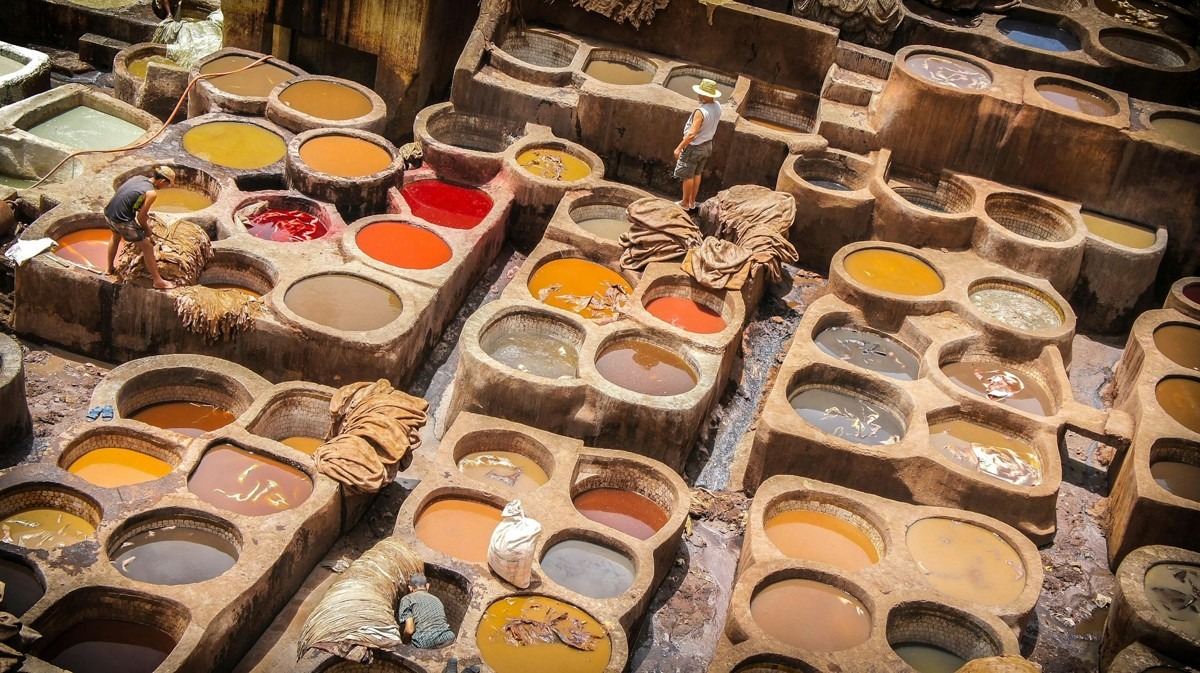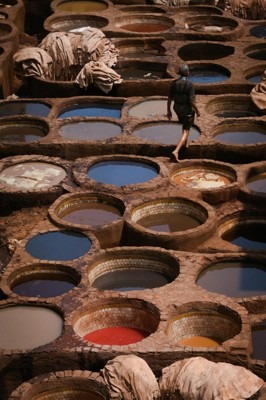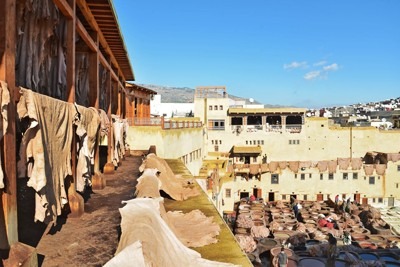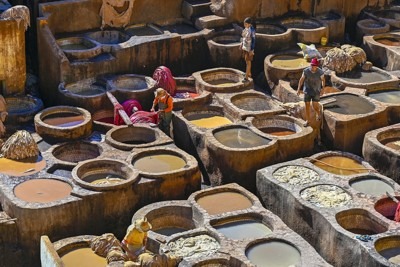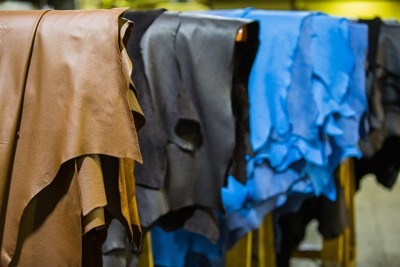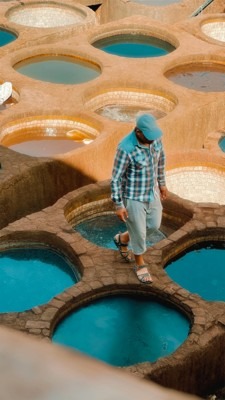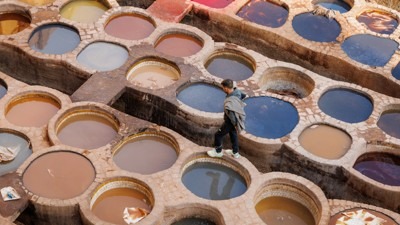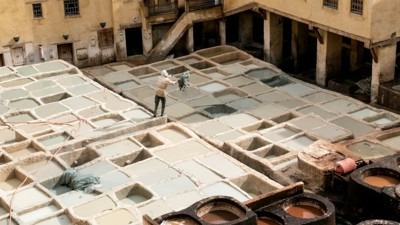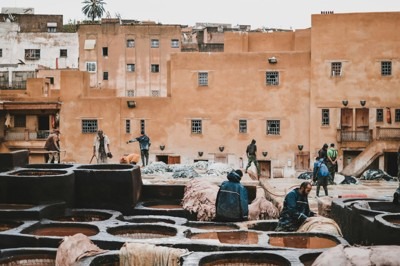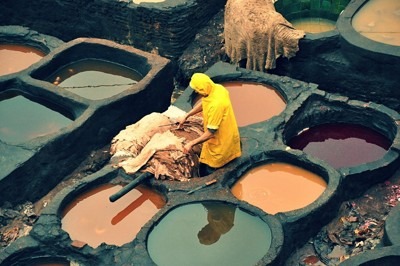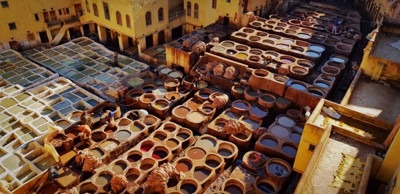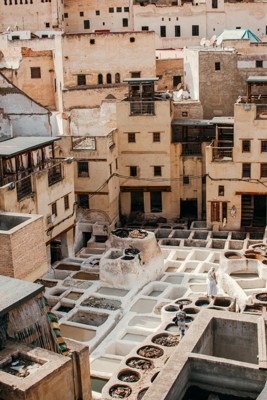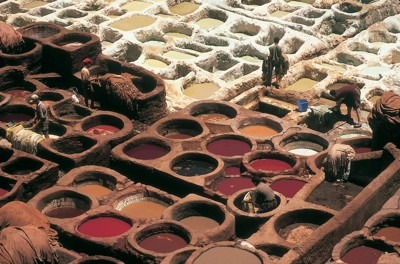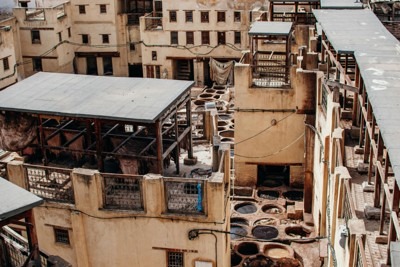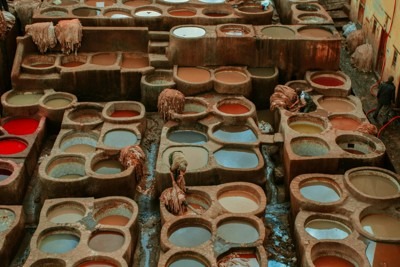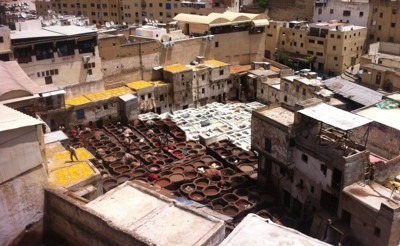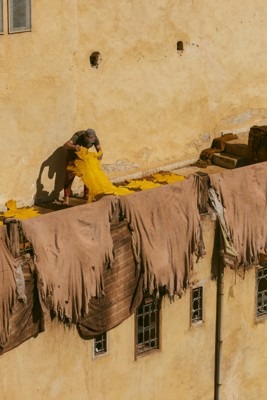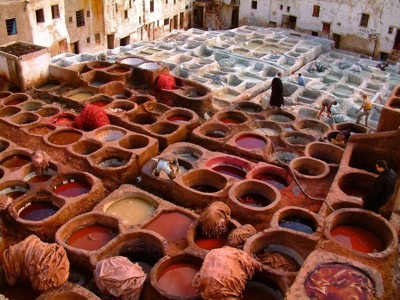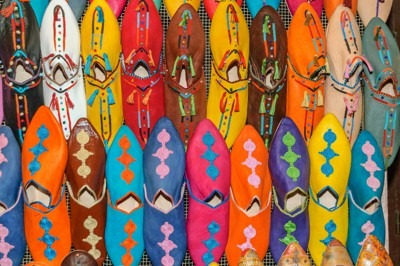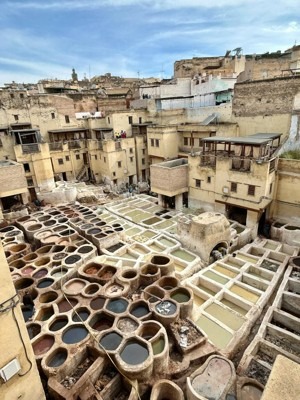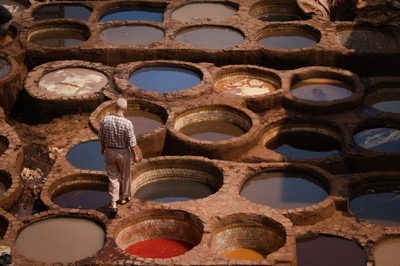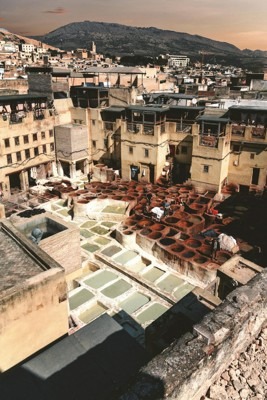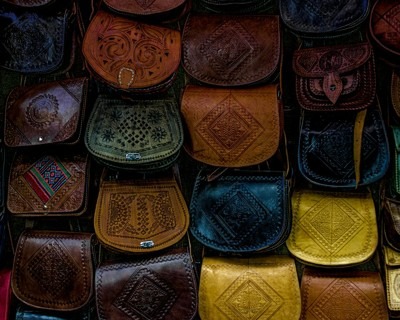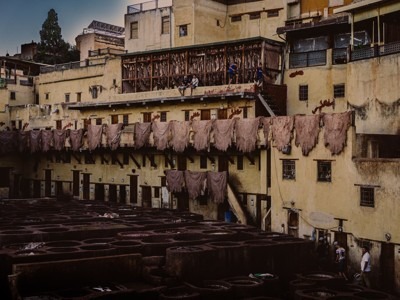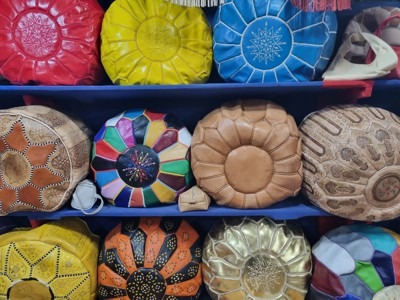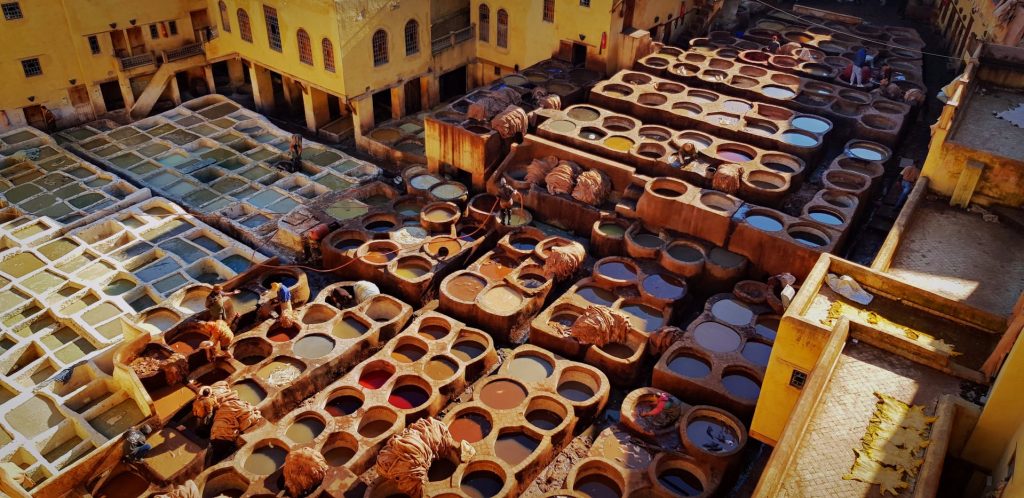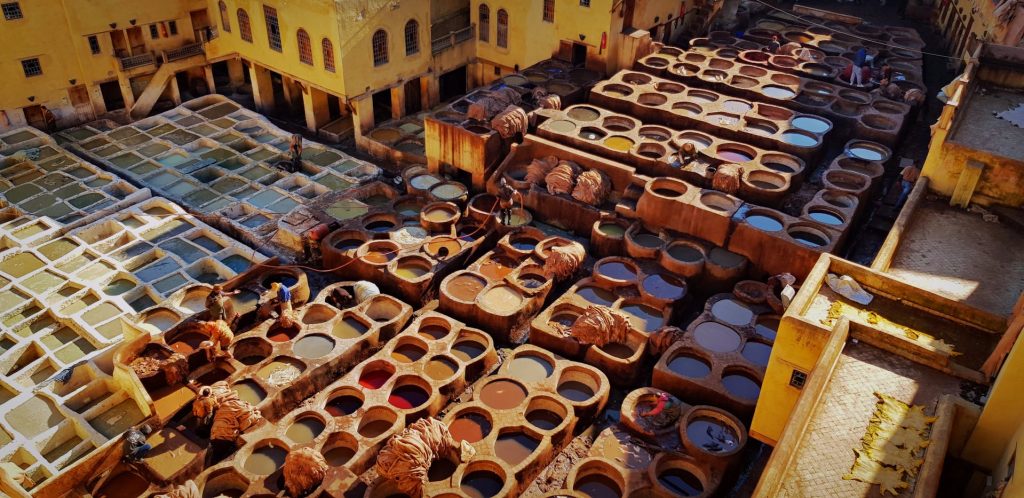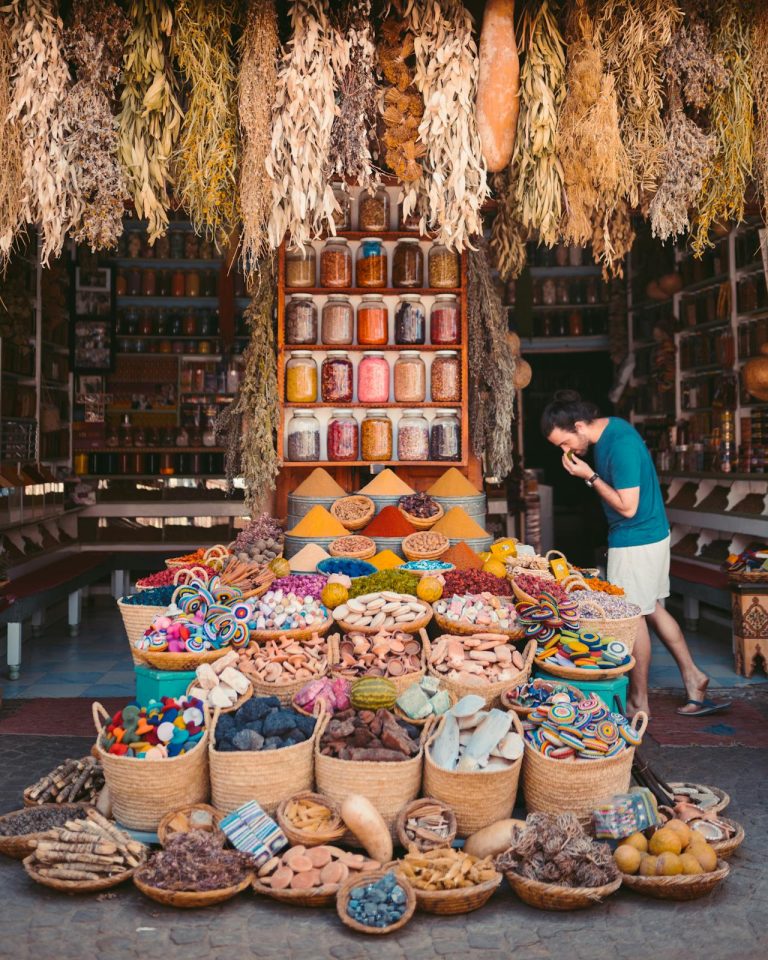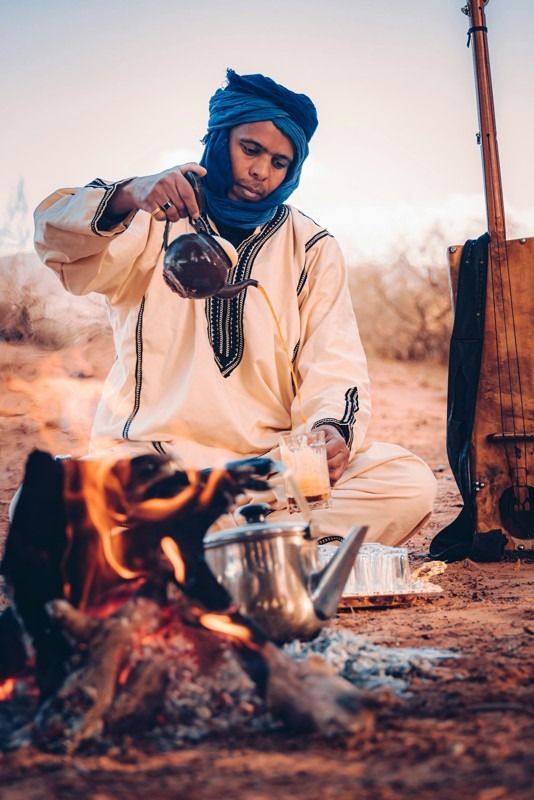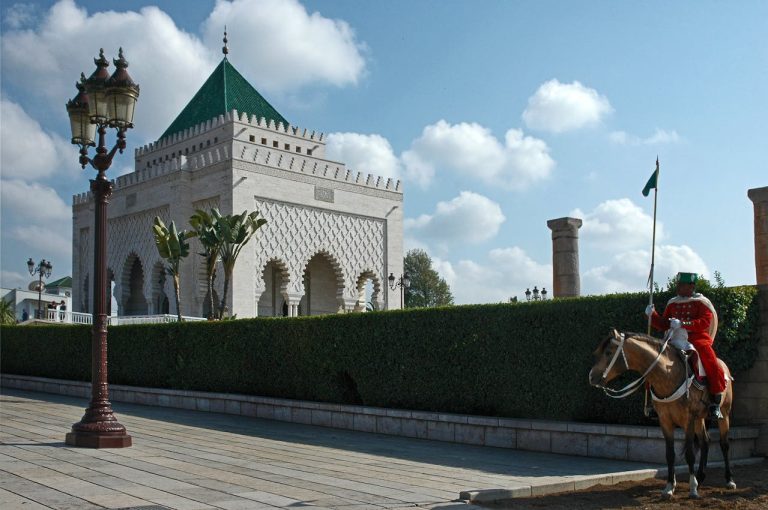Leather Tanneries of Fes: Where Ancient Craft Meets Modern Wonder
Leather tanneries—just the phrase itself conjures something visceral, doesn’t it? When I first descended into the ancient medina of Fes, following a narrow alleyway that twisted like a secret being reluctantly shared, I had no idea I was about to witness something that would fundamentally change how I understood craftsmanship. The smell hit me first (we’ll get to that), then the sight—a sprawling kaleidoscope of circular stone vats filled with dyes so vibrant they seemed almost photoshopped against the weathered medieval backdrop. But this wasn’t a museum piece or a carefully preserved historical site. This was—and remains—a living, breathing workspace where men have been transforming animal hides into buttery-soft leather for over a thousand years, using methods that would make modern safety inspectors weep.
The Fes tanneries aren’t just a tourist attraction, though they’ve certainly become that too. They’re a testament to human persistence, to the kind of knowledge that gets passed down through generations because no textbook could ever capture it. And honestly? They’re also a reminder that beauty and harshness can exist in the same space, that what we consider luxurious often begins in conditions we’d rather not think about.
Traditional Leather Making Process: Poetry Written in Pigeon Droppings
Let me be direct about something—the traditional leather-making process in Fes is not for the faint of heart, and anyone who tells you otherwise is selling you a sanitized version of reality. I’ve watched this ancient craft unfold dozens of times, and it never stops being simultaneously fascinating and slightly horrifying.
The process begins with raw animal hides (mostly cow, sheep, and goat) being soaked in a mixture that would make your stomach turn: water, pigeon droppings, quicklime, and salt. The pigeon droppings—collected from rooftops across the city in a network that feels almost medieval in its efficiency—contain enzymes that help soften the hides. I remember asking one of the workers, Ahmed, about this particular ingredient, and he just shrugged with the kind of matter-of-factness that comes from doing something your grandfather’s grandfather did. “The pigeons give us what we need,” he said, as if explaining that water is wet.
This initial soaking can last up to three days. The hides bloat and soften, shedding their hair and outer layers. Workers wade through these preparatory vats barefoot—yes, barefoot—scraping and turning the hides with practiced movements that look almost like a dance if you watch long enough. The physical toll is obvious; these are men whose hands tell stories of decades spent in chemical baths, whose backs bear the weight of tradition in the most literal sense.
After the softening phase comes the Moroccan leather dyeing process, and this is where the tanneries transform into something that photographs can barely capture. The hides are moved to smaller vats—dozens, sometimes hundreds of circular stone pools arranged in honeycomb patterns—each filled with natural dyes derived from plants, minerals, and other organic materials. Poppy flowers create red. Indigo brings forth deep blues. Saffron (yes, actual saffron, because Morocco doesn’t do anything halfway) produces those luminous yellows. Mint generates rich greens, while henna offers earthy browns.
The color saturation is almost aggressive in its intensity. Standing on the viewing terraces that overlook the tanneries, you see what looks like a painter’s palette exploded across ancient stone—cerulean blues next to crimson reds, sunshine yellows adjacent to forest greens. Men stand waist-deep in these vats, stomping and kneading the leather with their feet for hours, ensuring even dye penetration. It’s backbreaking, it’s messy, and it’s absolutely hypnotic to watch.
The Chouara Tannery Experience: Assault on the Senses (Worth Every Moment)
The Chouara Tannery—the largest and most famous of Fes’s tanneries—offers an experience that I still struggle to adequately describe to people who haven’t been there. Located in the heart of the old medina, this sprawling complex has been operating since at least the 11th century, possibly longer. The historical records get fuzzy when you go back that far, which somehow makes it even more impressive.
Your guide (and trust me, you want a guide for this—the medina’s layout was designed to confuse invading armies, and it still works on modern tourists) will typically lead you through a leather goods shop first. This isn’t just a sales tactic (though yes, they’re hoping you’ll buy something later); these shops have viewing terraces that overlook the tanneries, providing the best vantage points. Before stepping out onto the terrace, you’ll be offered a sprig of fresh mint. Take it. Hold it near your nose. You’ll understand why in about thirty seconds.
The smell is… profound. There’s no delicate way to put this—rotting flesh, fermenting organic matter, lime, ammonia, and various other compounds create an olfactory cocktail that hits you like a physical force. I’ve seen grown adults literally stagger backward. The mint helps somewhat, though I’ve learned over the years that you eventually just have to surrender to the sensory experience. Fighting it makes it worse. After about ten minutes, your nose actually begins to adapt (a small mercy from our evolutionary biology).
But then you look down, and suddenly the smell becomes secondary. The artisan craftsmanship in Morocco reveals itself in patterns that seem almost impossible—hundreds of stone vats, workers moving with choreographed precision, and hides being transferred from soaking pools to dyeing vats in a system that has no written manual, no computer management, and no modern logistics. It works because everyone knows their role, learned through years of apprenticeship and observation.
I once visited during the early morning, around 7 AM, when the winter sun was just beginning to cut through the medina’s narrow streets. The steam rising from the vats created this ethereal atmosphere, and the workers—silhouetted against the rising mist—looked like figures from another time. Because, in a sense, they are. The techniques haven’t changed substantially in centuries. The tools are still largely the same. Even the layout of the tannery vats follows patterns established when Fes was the intellectual and commercial capital of North Africa.
Fes Medina Workshops: Where Transformation Happens Beyond the Vats
The tanneries themselves are just one part of a larger ecosystem. The Fes medina workshops that surround and support the leather industry create a network of specialized knowledge that’s become increasingly rare in our globalized world. After the leather has been dyed and dried—a process that can take several days depending on weather conditions—it moves to different workshops for finishing.
There are workshops specializing in leather softening, where workers spend hours kneading and stretching the dried hides to achieve that supple texture that makes Moroccan leather so prized. I watched a craftsman named Hassan work a piece of dyed goatskin for what must have been forty-five minutes, his hands moving in repetitive motions that had worn grooves into his worktable. “Each hide is different,” he explained without looking up. “You have to feel where it’s stiff, where it needs more work. Machines can’t feel.”
Other workshops focus on cutting and pattern-making. These spaces—often tiny rooms accessed through doorways you have to duck to enter—contain cutting tables that have been used by generations of the same family. The patterns for traditional babouche slippers, for handbags, for jackets, and for cushion covers—these are stored not in filing cabinets but in the muscle memory of craftsmen who learned by watching their fathers, who learned from their fathers.
The stitching workshops are where I’ve spent some of my favorite afternoons in Fes. There’s something meditative about watching someone hand-stitch a leather bag using techniques that haven’t changed in centuries. No sewing machines here (well, some of the more modern workshops have them, but the traditional ones resist). Just a needle, thread, and hands that have done this so many times they barely need to look.
One craftsman showed me a traditional tanning method for finishing edges that involved beeswax and a heated metal tool. The precision required to burnish leather edges without scorching them is something I tried myself once. I lasted about three minutes before I realized I was in the presence of mastery that takes decades to develop. “You make it look easy,” I told him. He laughed—a sound like rocks tumbling. “My hands know,” he said. “My brain stopped being involved years ago.”
The Cultural Heritage of Fes: Written in Leather and Labor
When UNESCO designated the Fes el-Bali (Old Fes) medina as a World Heritage site in 1981, the tanneries were a significant part of that recognition. The cultural heritage of Fes isn’t just about beautiful buildings or historical monuments—it’s about living traditions, about economic activities that have sustained communities for over a millennium.
The tannery system represents something increasingly rare: a complete, functioning medieval industry surviving into the 21st century. Not as a museum piece or a historical reenactment, but as an actual business employing hundreds of people using methods that would be recognizable to their ancestors from the 1100s. This continuity is both the tanneries’ greatest strength and their most significant vulnerability.
The social structure around the tanneries reflects traditional Moroccan craft organization. Master craftsmen (maâlems) sit at the top of a hierarchy that includes journeymen and apprentices. Young men—usually starting around age fourteen or fifteen—begin learning the trade through direct observation and gradually increasing responsibility. There’s no formal training program, no certification. You learn by doing, by making mistakes (though costly mistakes can end an apprenticeship quickly), and by absorbing knowledge through osmosis.
I’ve spoken with several young apprentices over the years, and their perspectives reveal interesting tensions. Some see the tanneries as their birthright, a continuation of family tradition that fills them with pride. Others view it as their only option in a city where unemployment runs high, especially for young people without university degrees. A few—increasingly, I’ve noticed—see it as something to do while they pursue other dreams, a stopgap rather than a career.
The historic tanneries of Morocco face real challenges in attracting and retaining young workers. The work is physically demanding, the pay is modest compared to what a young person might earn in tourism or other sectors, and the health concerns are real. Prolonged exposure to the chemicals used in tanning—even natural ones—takes a toll. Many older workers show signs of respiratory issues, skin conditions, and joint problems from years of standing in cold water and caustic solutions.
Yet the tradition persists, adapted but recognizable. Some tanneries have made small concessions to modernity—better drainage, slightly improved ventilation, occasional use of protective gear (though many workers resist this, claiming it interferes with their ability to feel the leather properly). The core process, however, remains stubbornly traditional, because attempts to modernize it have consistently resulted in inferior leather.
Moroccan Craftsmanship: The Luxury Built on Humble Foundations
Here’s something that fascinates me about the disconnect between production and consumption: the leather goods that emerge from these malodorous, medieval workshops end up in some of the world’s most exclusive boutiques. Moroccan craftsmanship has a reputation that commands premium prices in European and American markets, and a significant portion of that reputation rests on leather goods produced in Fes using these ancient methods.
The irony isn’t lost on the craftsmen themselves. I remember a conversation with a leather artisan named Youssef who showed me photographs of his work in a Paris shop window, priced at amounts that represented several months of his wages. He wasn’t bitter about it—or if he was, he hid it well behind a philosophical shrug. “The work is what matters,” he said. “Where it goes after… that’s someone else’s story.”
The quality is undeniable, though. Leather tanned using these traditional methods develops characteristics that chemical tanning simply cannot replicate. The natural dyes create subtle color variations—each hide is genuinely unique. The manual processing results in leather that ages beautifully, developing patina and character rather than simply wearing out. Handbags, jackets, and cushions made from Fes leather often improve with use, the leather softening and deepening in color.
I own a leather messenger bag I purchased directly from a workshop in Fes about twelve years ago. It cost me the equivalent of about sixty dollars—a price the craftsman initially asked for, then tried to lower because he thought I was hesitating (I wasn’t; I was just trying to do the currency conversion in my head). That bag has traveled with me to thirty-something countries. It’s been soaked in monsoon rains, baked in desert heat, frozen in Nordic winters, and crushed in overhead compartments. It looks better now than when I bought it. The leather has developed this rich, complex color that no factory could produce. Every scratch tells a story. That’s what Moroccan leather goods offer—objects that accumulate history rather than just age.
Visiting Fes Tanneries: Practical Reality Behind the Instagram Posts
Let’s talk logistics, because the visiting Fes tanneries experience requires some preparation and realistic expectations. First: timing matters significantly. The tanneries operate year-round, but the experience varies dramatically by season.
Summer visits (June through August) intensify everything—the heat makes the smells more pungent (something I didn’t think possible until I experienced it), and the intense sun creates a different kind of visual beauty but also means the workers are laboring in truly brutal conditions. If you go in summer, go early morning or late afternoon. Midday is genuinely punishing for everyone involved.
Winter visits (December through February) offer milder temperatures and the benefit of those misty morning scenes I mentioned earlier, but it also means the drying process takes longer, so you might see fewer vats in active use. Spring and fall provide the most comfortable visiting conditions, though Fes during spring festival season can be crowded beyond belief.
About guides: yes, you technically can find the tanneries yourself—the Chouara Tannery specifically is marked on many maps, and locals will point you in the right direction if you ask. However, I strongly recommend hiring a licensed guide, preferably one recommended by your riad or a reputable tour company. The medina is genuinely confusing—I’ve been visiting for over twenty years and still occasionally take wrong turns—and a good guide adds context that transforms the experience from mere observation to actual understanding.
The viewing terraces I mentioned are typically accessed through leather shops, and yes, there’s an expectation that you’ll at least look at their merchandise. You’re under no obligation to buy, but these shops do provide the best viewpoints, and the shopkeepers have arrangements with the tanneries to allow tourist access. A small tip (20-50 dirhams is appropriate) if you’re not purchasing anything is a courteous gesture.
Photography is generally allowed and encouraged—the tanneries photograph beautifully from the terraces—but please, please be respectful about photographing the workers themselves. These are men doing difficult labor, not tourist attractions. Ask permission (through your guide) before taking close-up photographs of specific individuals. I’ve seen tourists treating the tannery workers like zoo animals, snapping endless photos without acknowledgment, and it’s uncomfortable to witness.
The mint sprigs: accept them gratefully, but don’t feel embarrassed if the smell still overwhelms you. I’ve seen everyone from seasoned travelers to local Moroccans struggle with it. It’s not a weakness; it’s biology. Some people have more sensitive olfactory systems. If you find it truly unbearable, it’s okay to keep your visit brief. The craftsmen understand—they sometimes joke that the smell is how they keep their trade secrets, because it discourages competition.
Leather Workshops in Morocco: Beyond Fes—A Broader Context
While Fes rightly claims pride of place in Morocco’s leather industry, understanding the broader landscape of leather workshops in Morocco provides useful context. Marrakech has its own tanneries—smaller than Fes’s but still operating traditionally. The Marrakech tanneries cater more heavily to the tourist market, with more polished viewing experiences and less of the raw authenticity that makes Fes simultaneously appealing and challenging.
Rabat and Taroudant also maintain traditional leather workshops, though on smaller scales. Each region has developed slight variations in technique and specialization. Taroudant, for instance, is known for particularly fine babouche slippers, while certain workshops outside Essaouira specialize in leather goods decorated with thuya wood inlay—a regional specialty.
What makes Fes different—what makes it the heart of Morocco’s artisan craftsmanship—is the scale and the preservation of the complete traditional system. Other cities have modernized more and adopted hybrid techniques that incorporate some mechanical processing. Fes has resisted this, for better and worse. The result is an experience that feels genuinely historical but also raises questions about sustainability—both environmental and human.
The Uncomfortable Questions: Progress vs. Preservation
I’ve avoided this topic until now because it’s complex and doesn’t have easy answers, but any honest discussion of the Fes tanneries must address the tension between preservation and progress. The working conditions, while traditional, are objectively harsh. The environmental impact of dumping tanning chemicals—even natural ones—into the river system is significant. The health effects on workers, while less severe than those from chrome tanning used in modern factories, are still concerning.
There have been proposals over the years to modernize the tanneries—improve ventilation, provide protective equipment, and update waste management systems. These proposals typically founder on practical objections: the physical layout of the centuries-old medina makes infrastructure improvements difficult and expensive. Workers often resist changes that alter traditional methods, fearing (sometimes correctly) that modernization is a step toward eventual mechanization and job loss.
The Moroccan government faces a genuine dilemma. The tanneries are a significant tourist draw—millions of visitors mean millions in revenue. They’re also an important source of employment in a city where jobs are scarce. But they’re also an environmental concern and a potential health liability. UNESCO’s heritage designation actually makes certain kinds of modernization more complicated, as changes must be approved to ensure they don’t compromise the site’s historical integrity.
I don’t have solutions to offer here—I’m a travel writer, not a policy expert. But I think visitors should come to the tanneries with eyes open to these complexities. What you’re witnessing is beautiful, impressive, and problematic all at once. That’s more honest than the sanitized version where everything is either perfect or terrible. Reality is messier.
The Future Written in Tradition: Where Do We Go From Here?
The question I get asked most frequently about the Fes tanneries is whether they’ll still exist in twenty or thirty years. My honest answer: I don’t know. What I do know is that leather tanned in Fes using these traditional methods commands premium prices precisely because it’s increasingly rare. As long as there’s a market for authentic, traditionally made leather goods, there’s economic incentive to keep these workshops operating.
Some encouraging developments: several initiatives now train young craftsmen in traditional techniques while also teaching business and marketing skills. The goal is to help artisans capture more of the value chain, reducing dependence on intermediaries who traditionally take the largest profit margins. Digital platforms have made it easier for workshops to connect directly with international customers, though this remains a small fraction of total business.
Tourism’s role is ambiguous. The revenue from visitors helps justify the tanneries’ continued operation, but it also creates pressure to perform authenticity, to maintain picturesque decay rather than making practical improvements. I’ve noticed some tanneries now time certain activities for peak tourist hours, which feels slightly manufactured even as it remains genuinely traditional work.
The younger generation of Moroccan consumers—more educated, more traveled, and more connected to global trends—shows renewed interest in traditional crafts, partly driven by global movements toward sustainable and ethical consumption. This creates a new domestic market that could help support the tanneries’ future. Whether this interest translates into enough economic support to sustain the system remains to be seen.
The smell eventually fades from your clothes (a day or two of airing usually does it), but the memory of standing above those vibrant dye vats, watching craftsmen perform work their ancestors would recognize, stays with you differently. The Fes tanneries represent something increasingly rare in our standardized, optimized world: a commitment to process over efficiency, to quality over quantity, and to tradition over innovation.
They’re not a museum. They’re not a theme park. They’re a working industry that happens to operate according to medieval principles in a world of smartphones and supply chains. Visiting them requires tolerance for discomfort—olfactory, certainly, but also the discomfort of witnessing labor conditions that challenge our modern sensibilities. What you get in return is a glimpse into how humans have made beautiful things for centuries: through skill, patience, and backbreaking work that machines still cannot replicate.
Will your visit to the Fes leather tanneries be comfortable? No. Will it challenge your Instagram aesthetic with smells no filter can hide? Absolutely. Will it give you a deeper appreciation for craft, for tradition, for the real cost of quality? Without question. Some experiences are worth the discomfort. This is one of them.
Practical Information: The Chouara Tannery and other Fes tanneries are open daily except Friday mornings (prayer time). The best visiting hours are 9-11 AM and 4-6 PM. Entry to viewing terraces through leather shops is typically free, though small tips are appreciated. Hiring a licensed guide costs approximately 200-300 dirhams for a half-day medina tour, including the tanneries. Fes is accessible by train from major Moroccan cities, with the journey from Casablanca taking about 4 hours and from Marrakech about 7 hours. The old medina is best explored on foot, as most streets are too narrow for vehicles.
The story written in Fes leather is ultimately about human persistence—about maintaining craftsmanship in a world that often values speed over quality, about communities preserving identity through work that literally shapes their city’s character. That story, with all its complications and contradictions, deserves to be witnessed, understood, and yes, even celebrated, despite the smell.

